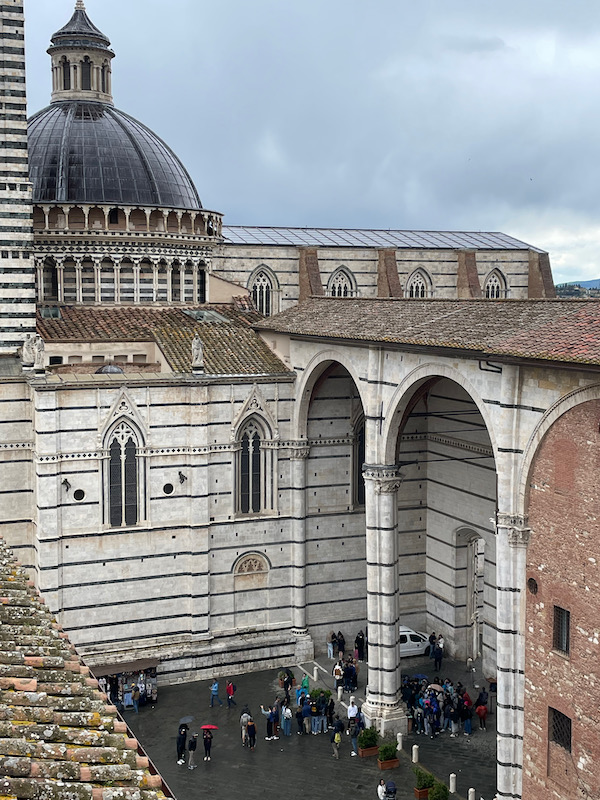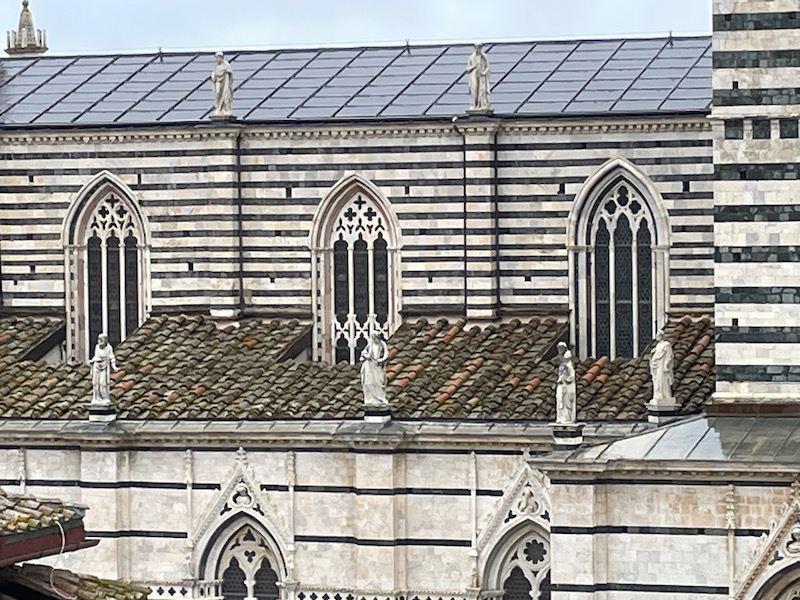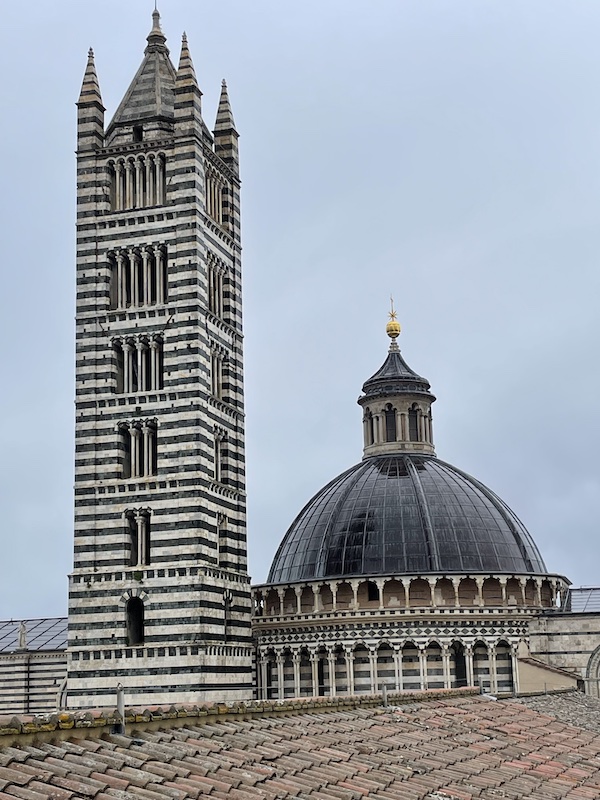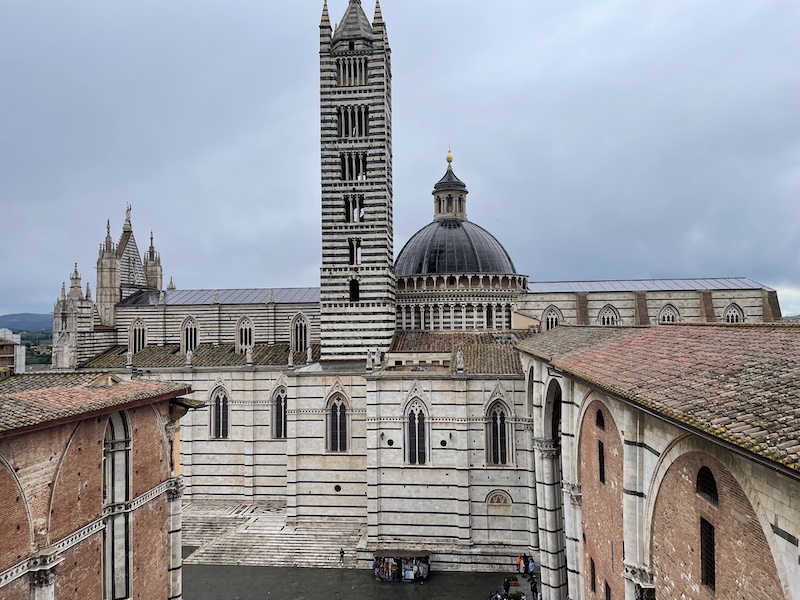Our Blog - Tuscany 2024 Trip - Siena Duomo Complex
The Siena Duomo, officially the "cattedrale metropolitana di Santa Maria Assunta", is part of a complex that you can visit together on a single ticket. There was a church here, perhaps in the 9th century, built on top of supposedly a temple to Minerva. However, it was facing the wrong direction and in the 13th century, it was transformed into a Basilica and the entrance changed to face West. The consecration of the new cathedral took place in 1179 in the presence of the Sienese Pope Alexander III. The sides and bell tower all show the distinctive black-and-white-stripes, while the front façade is highly sculpted. While it looks pretty unified, it can be split into upper- and lower- sections which were done by different people at different times. The bottom was done between 1284 and 1297 before the architect/sculptor suddenly moved out of town. The project was taken over by a different architect and the top was done between 1299 and 1317 in a Floral Gothic style. The bell tower was completed in 1313 in a Romanesque style.
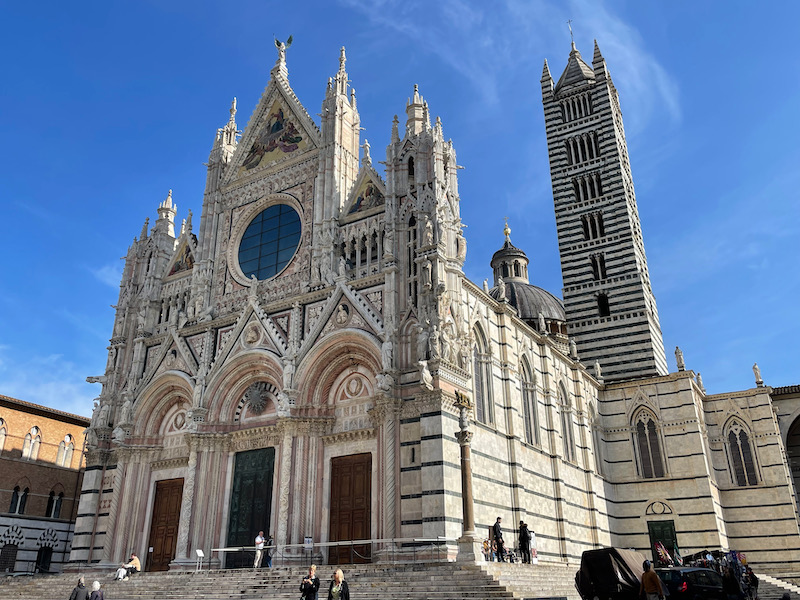
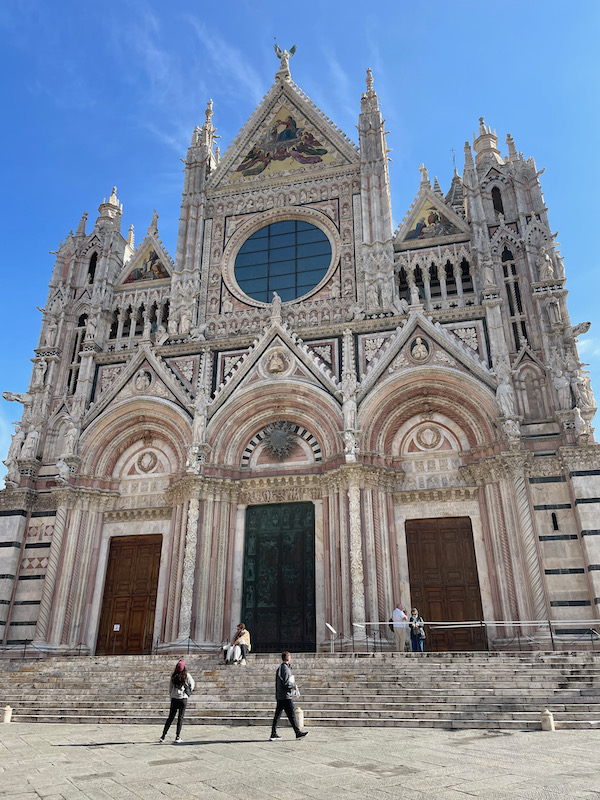
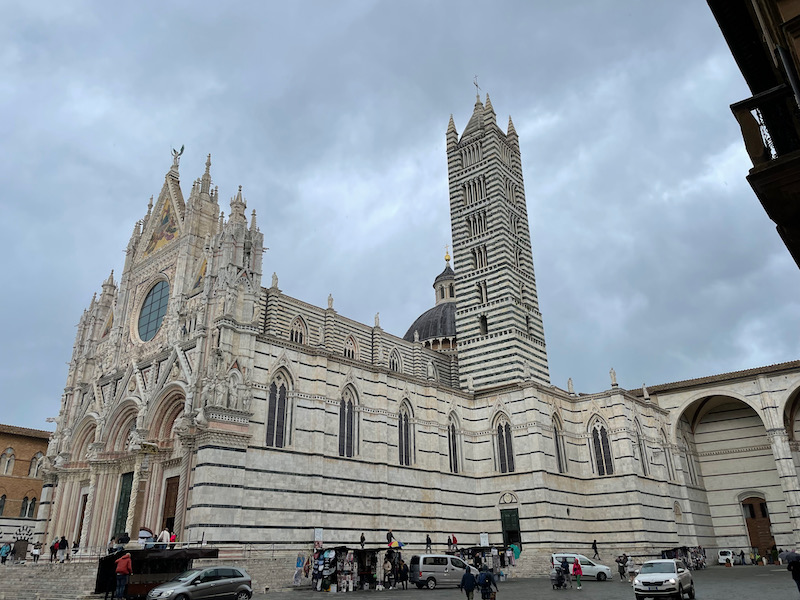
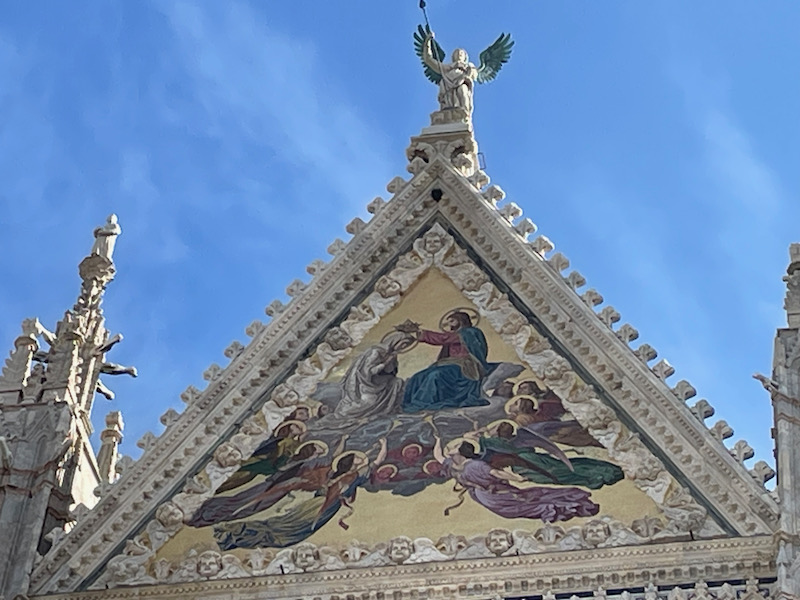
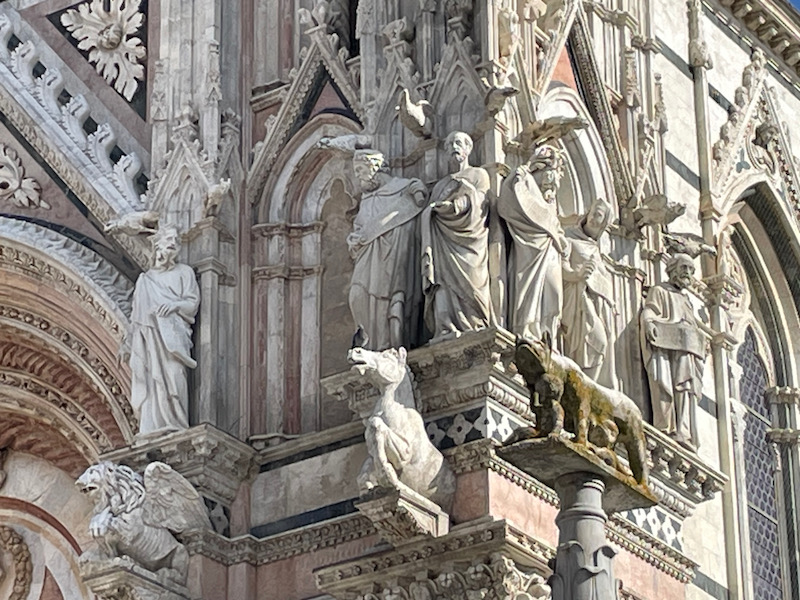
The interior is a bit dark due to the black-and-white stripes that continue on the inside and the artwork on the walls. The central nave and choir has a series of 171 busts of Popes above the Romanesque arches and 36 busts of emperors in the corners. The Popes are all named while the emperors are not. These were done in the late 15th and early 16th centuries.
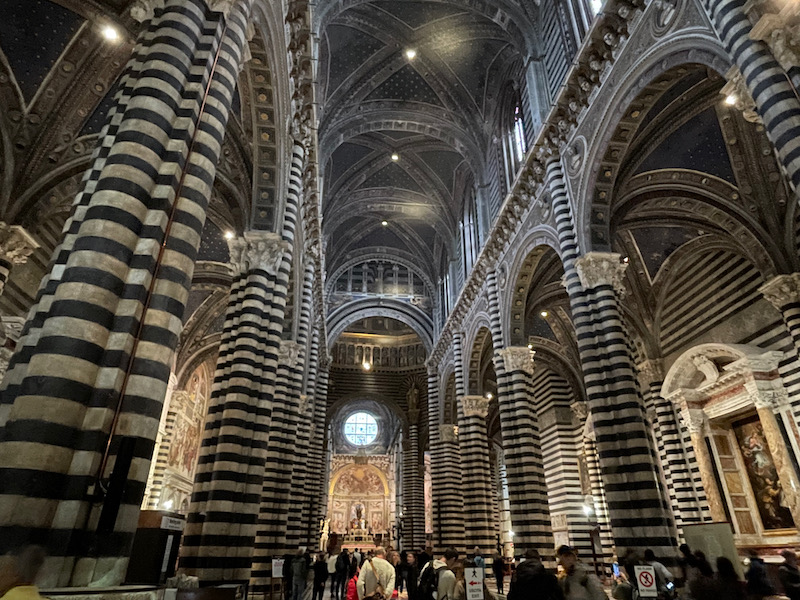
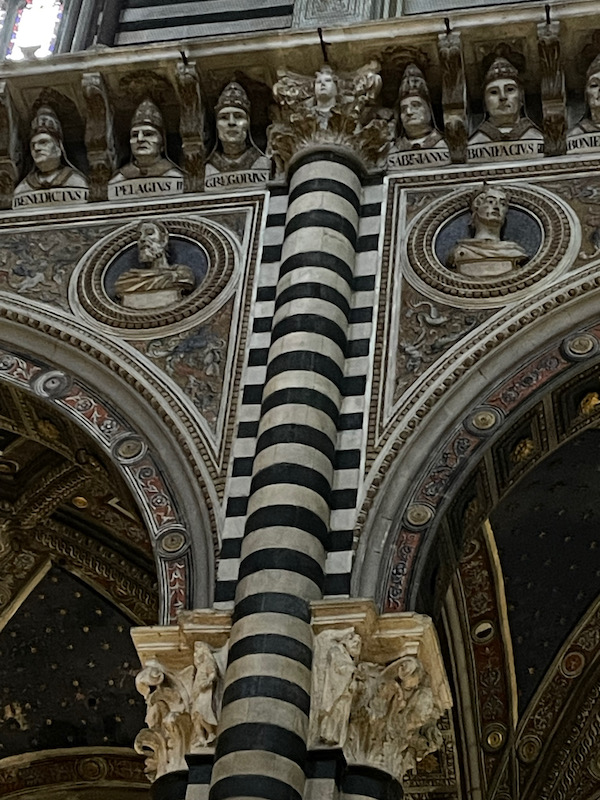
The main doorway is framed by a carved marble and was added in the 17th century. Above this is a rose window depicting The Last Supper which was created in 1549.
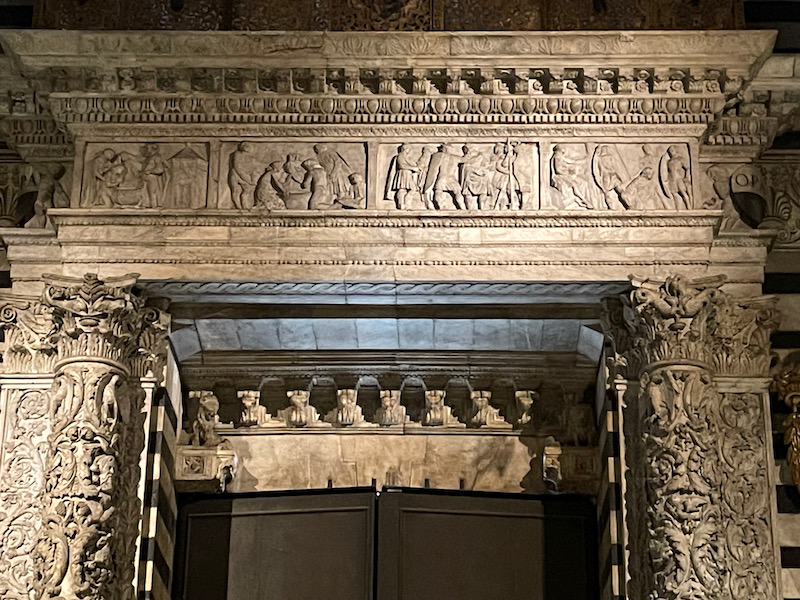
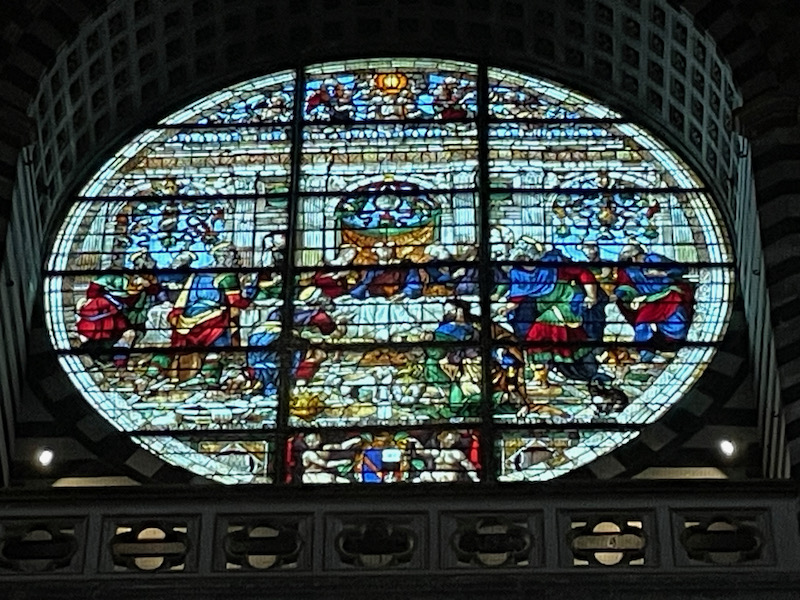
The high altar is polychrome marble. It was started in 1530 but the artist died in 1536 without finishing it. A set of marble workers continued the work, based on his plans, finishing in 1541. The Eucharist tabernacle is done in bronze, with bronze angels on the sides.
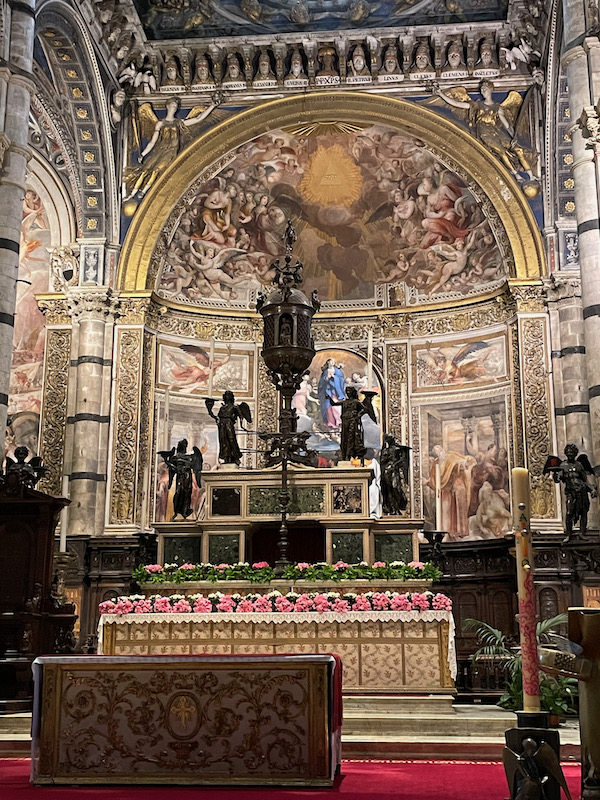
One of the frescoes in the apse, done in 1608-1611, showing the Wedding of Esther and Ahaseurus.
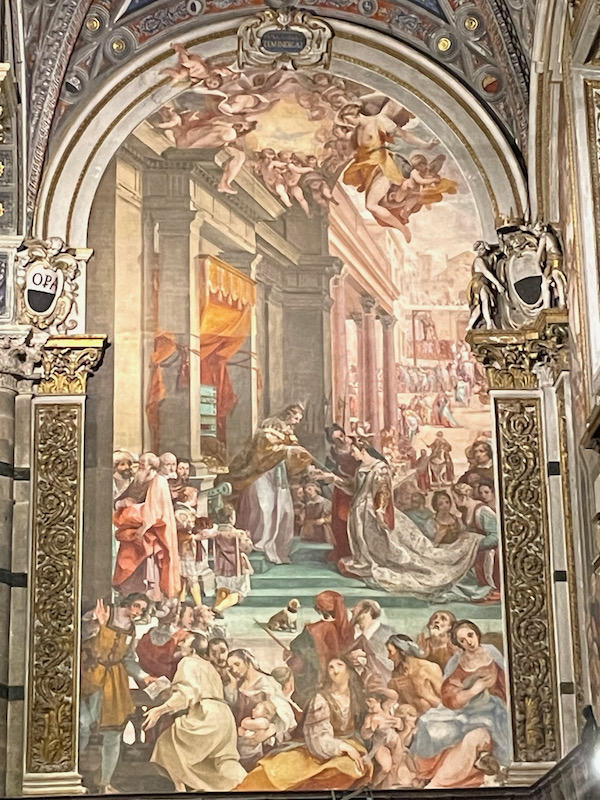
The octagonal pulpit was created between 1265 and 1268 with sculpted scenes around the top. Some of the columns sit on these nice lions.
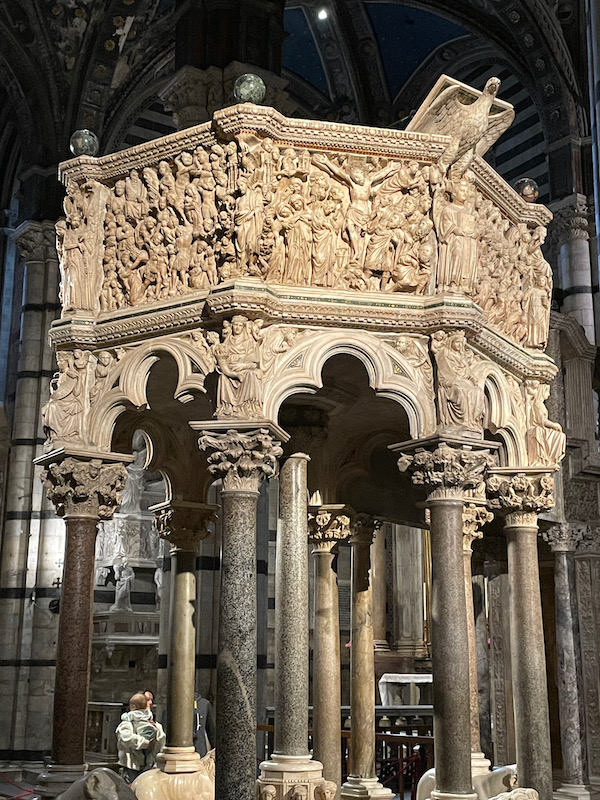
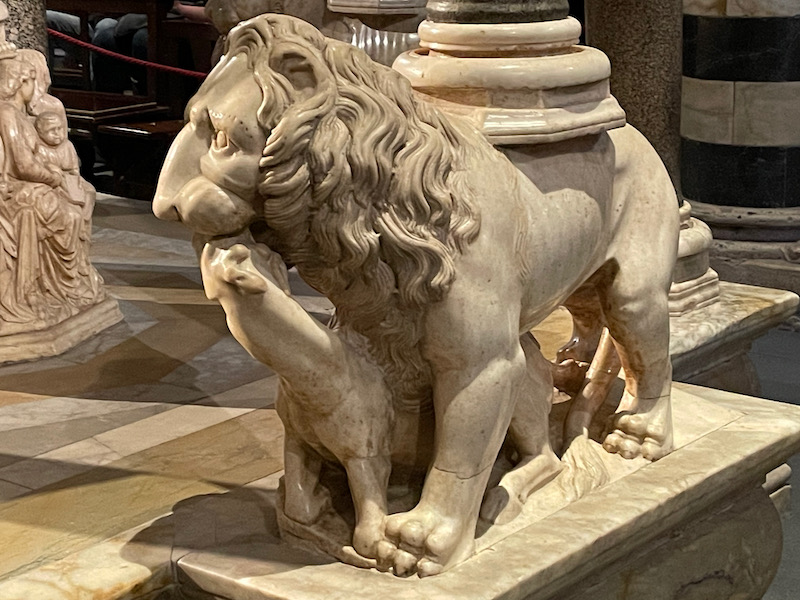
The floor of the cathedral is one of the largest and most valuable examples of a complex of marble inlays, a decorative project that lasted from the 14th to the 19th centuries. This first is from 1488 and is the first scene in front of the central portal depicting an Egyptian sage offering a book to the two men on the left.
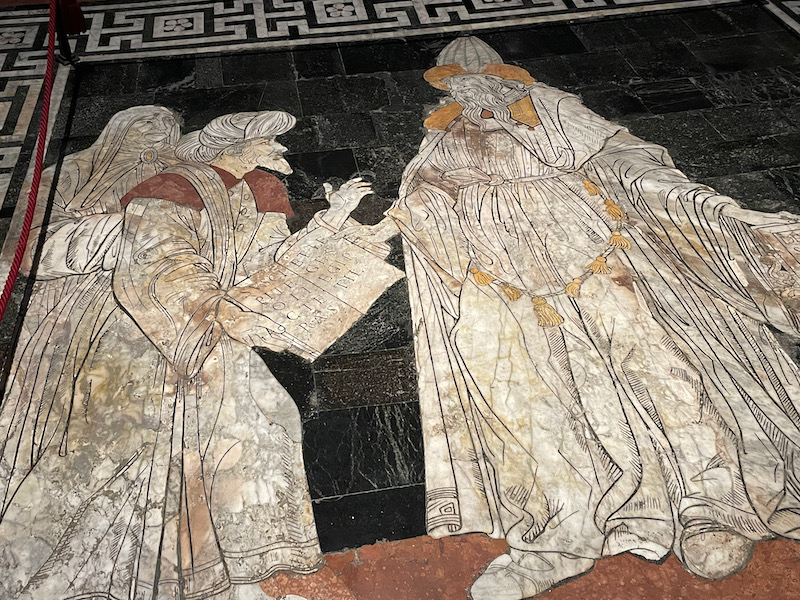
In classical antiquity, the "Sibyl" was a virgin endowed with prophetic virtues as she was inspired by a god, usually Apollo. Their representations are found along the side aisles, as symbols of the revelation of Christ through them to ancient humanity. I counted 10 different Sibyl's from various countries of the known world at that time. This one is the Hellespontic Sibyl, done in 1483. Born on Trojan soil, she holds a half-opened book with her hair falling freely on her shoulders. A wolf and a lion are sitting, giving each other a paw in a friendly manner: perhaps it is an allusion to the treaty between Siena and Florence.
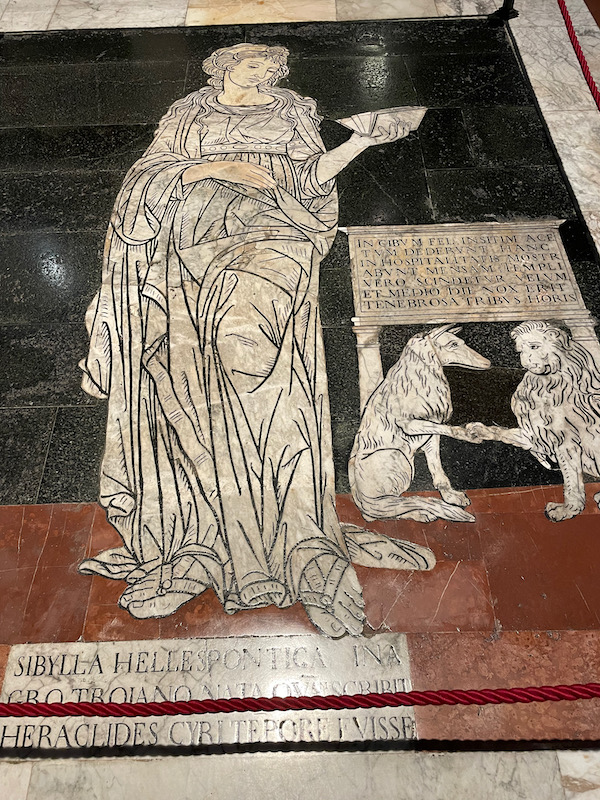
These last 2 are small portions of an inlay from 1481 entitled Massacre of the Innocents. The person standing is on the left side, almost watching the massacre taking place to the right of him, with soldiers on horseback.
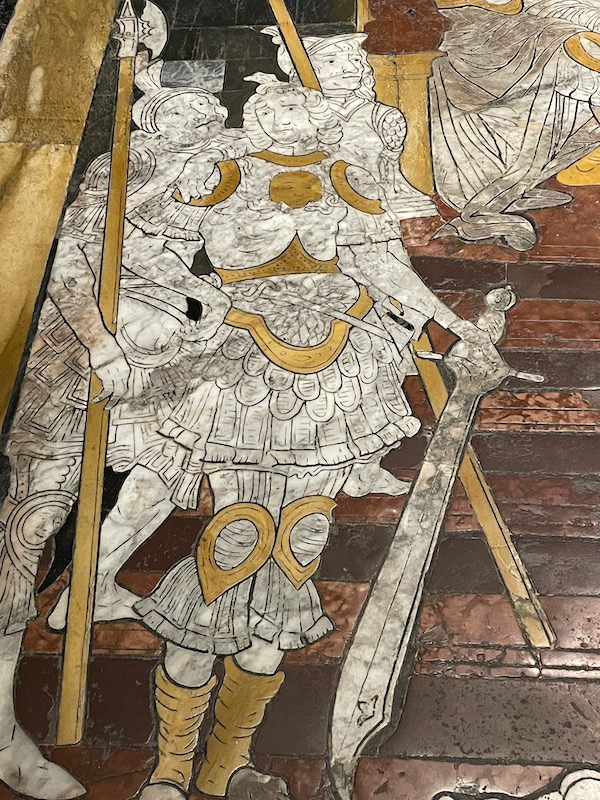
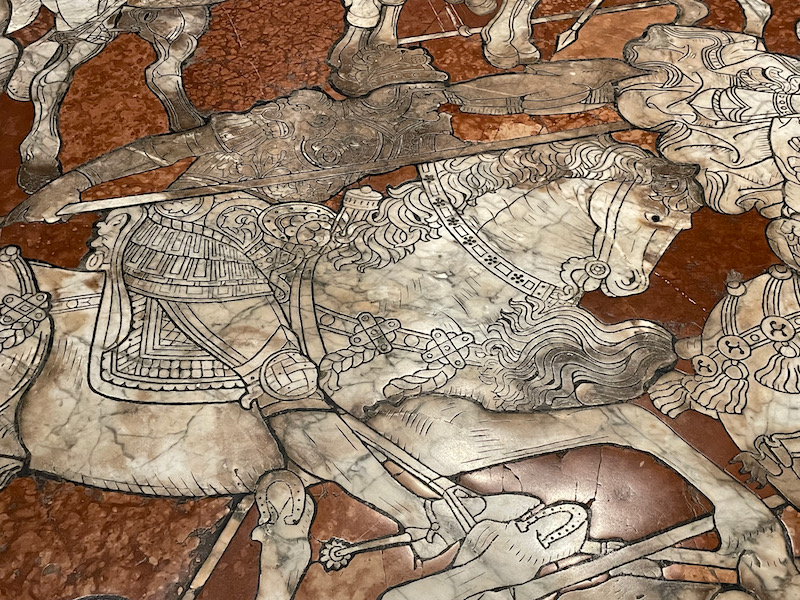
This large marble work is called the Piccolomini Altar. It was commissioned by the Cardinal Archbishop of Siena, Francesco Todeschini Piccolomini, who later became later Pope Pius III (although he was only Pope for only 26 days in 1503). The altar was created between 1481 and 1485 although the original artist was unable to complete the statues and so the Cardinal had to get other artists to create them. Between 1501 and 1504, Michelangelo created 4 statues for the lower niches but left after those because he was becoming too popular and had more important requests. The statue I show is Saint Paul, done by Michelangelo.
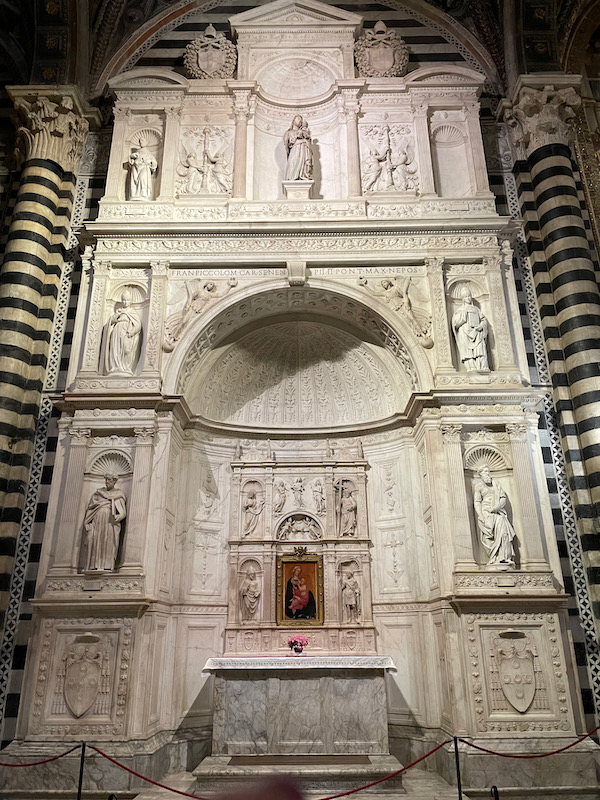
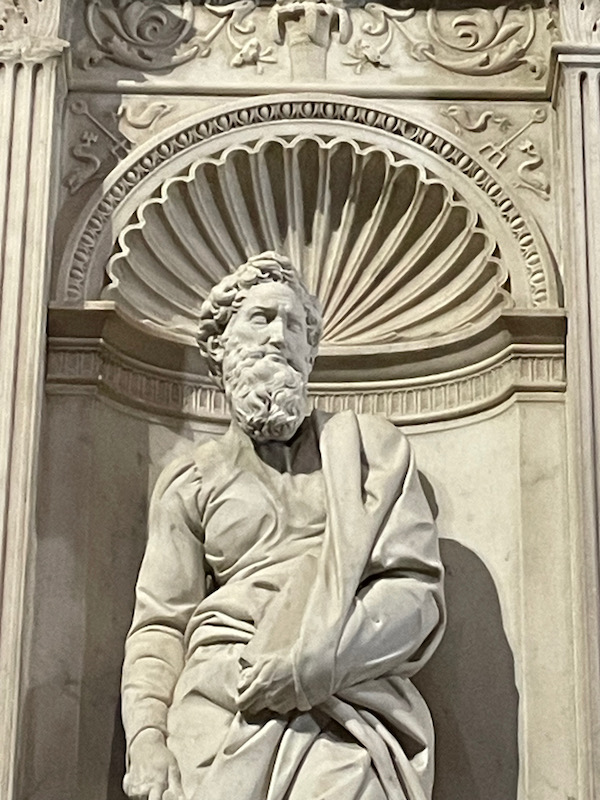
This fresco is on the entrance wall to the Piccolomini Library and shows the coronation of Pope Puis III, which took place in 1503.
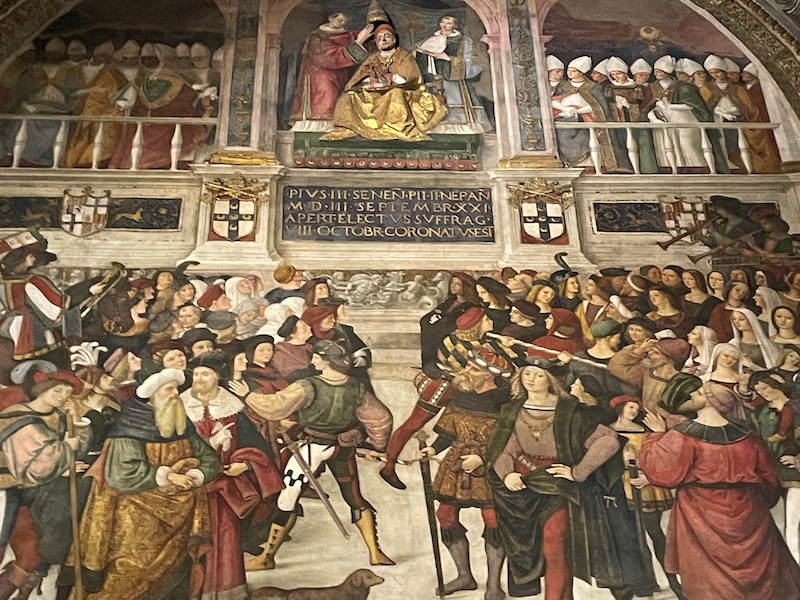
The Piccolomini Library is along the left nave of the Cathedral and was built in 1492 by the archbishop of Siena, Cardinal Francesco Piccolomini Todeschini (who later became Pope Pius III). It was designed to safeguard the very rich book heritage collected by his uncle, Pope Pius II. The walls and ceiling of the room are totally covered with frescoes. The walls are divided into scenes from the life of Pope Pius II.
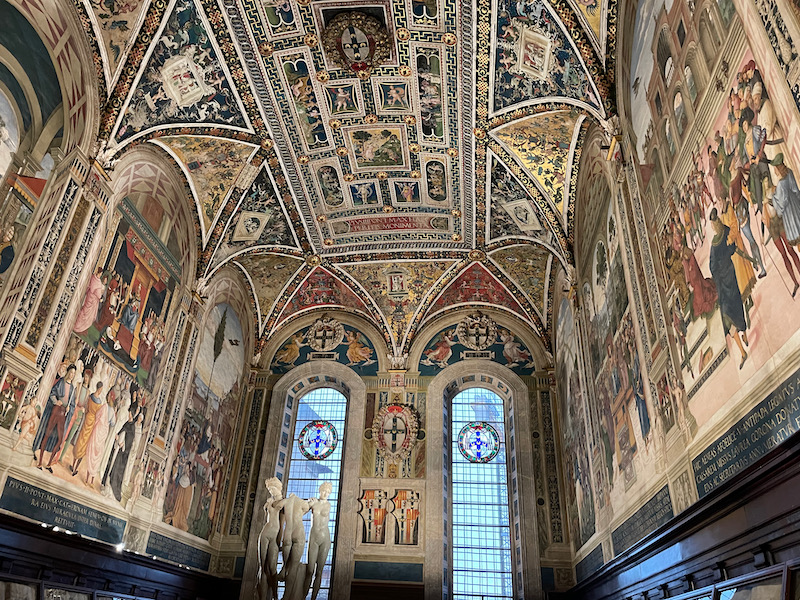
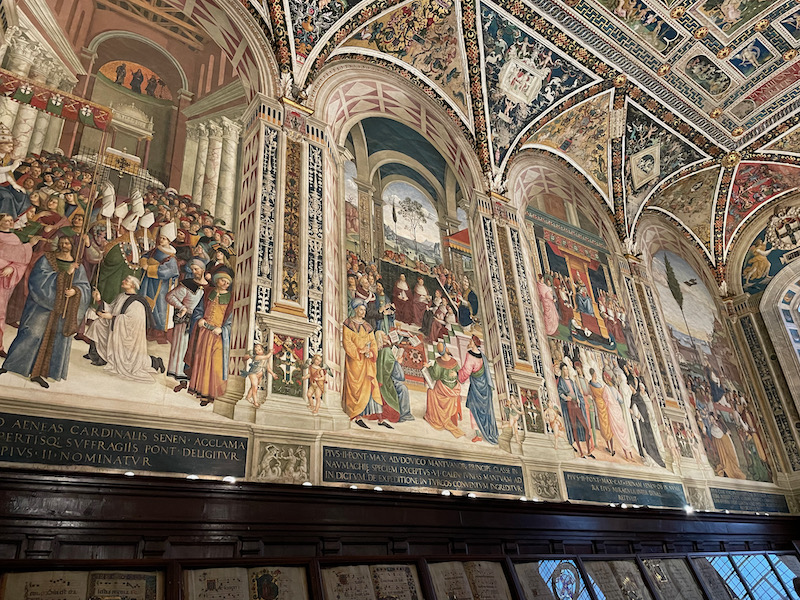
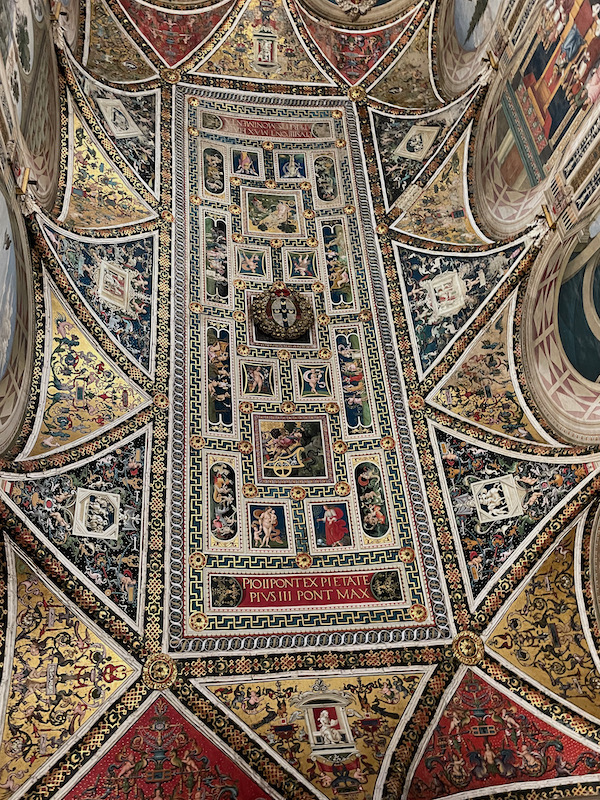
A couple of these scenes, the first being Enea Silvio, bishop of Siena, presents Eleonora of Aragon to Emperor Frederick III. The 2nd is Pius II arrives in Ancona to begin the crusade, which was the last thing he did before dying in 1464. The Ottoman Turks had just conquered Constantinople and were about to take possession of the entire Byzantine Empire, under the leadership of Muhammad II. Old and ill, Pope Puis II left Rome in June 1464 to go to Ancona to personally lead the Crusader army as it left the port for the crusade. He died in August of that year and the Crusader army immediately disbanded after his death.
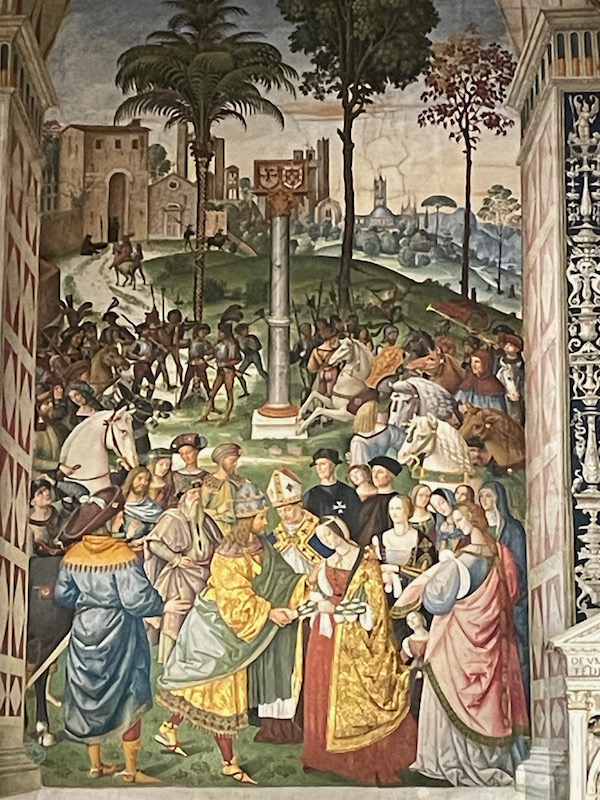
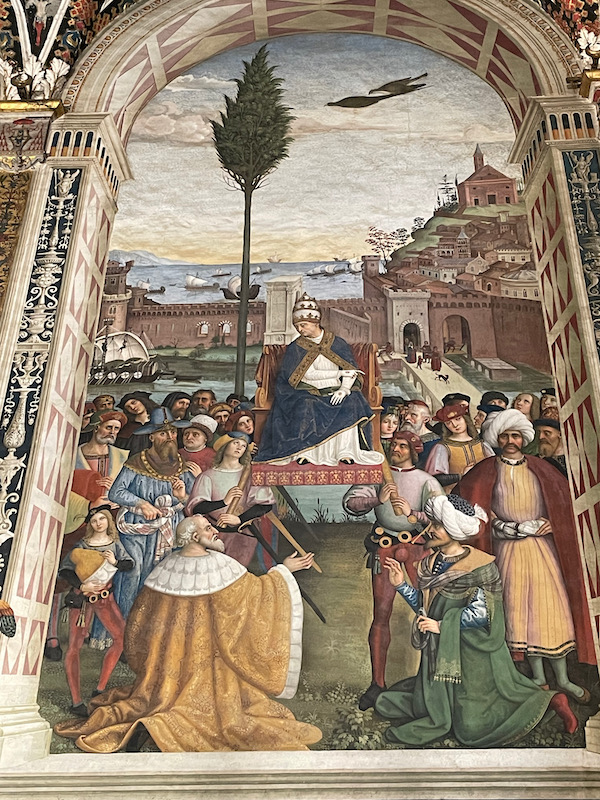
The cases around the walls contain a series of "illuminated" manuscripts from the 15th century. I had to go look up what an "Illuminated" manuscript was, as I thought the translation was off. In fact, an illuminated manuscript is a formally prepared document where the text is decorated with borders and miniature illustrations.
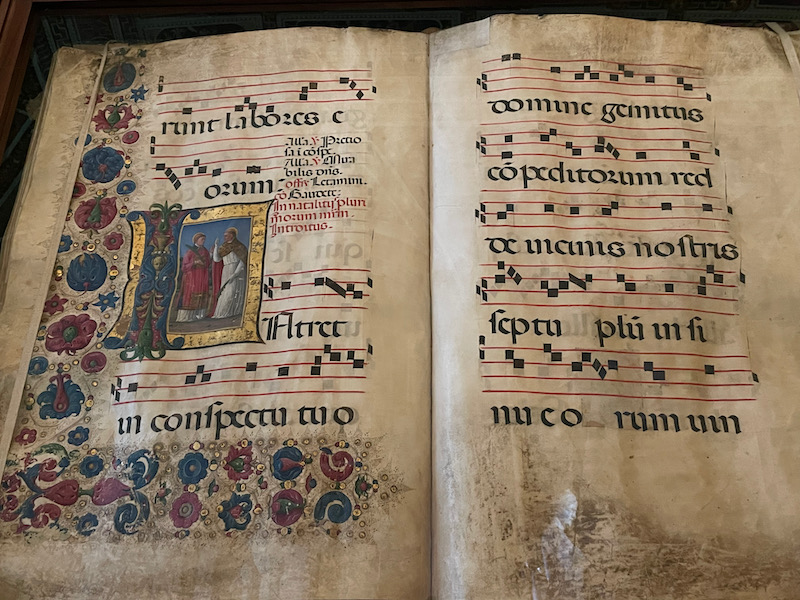
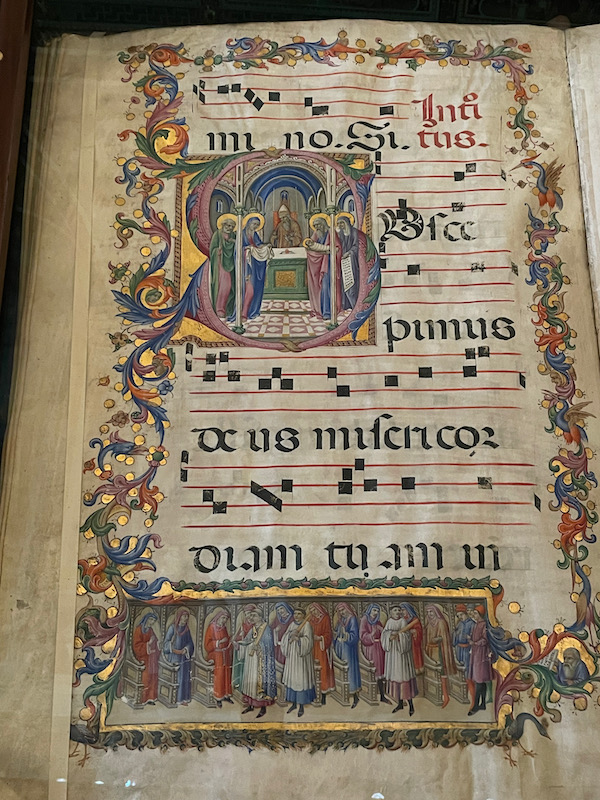
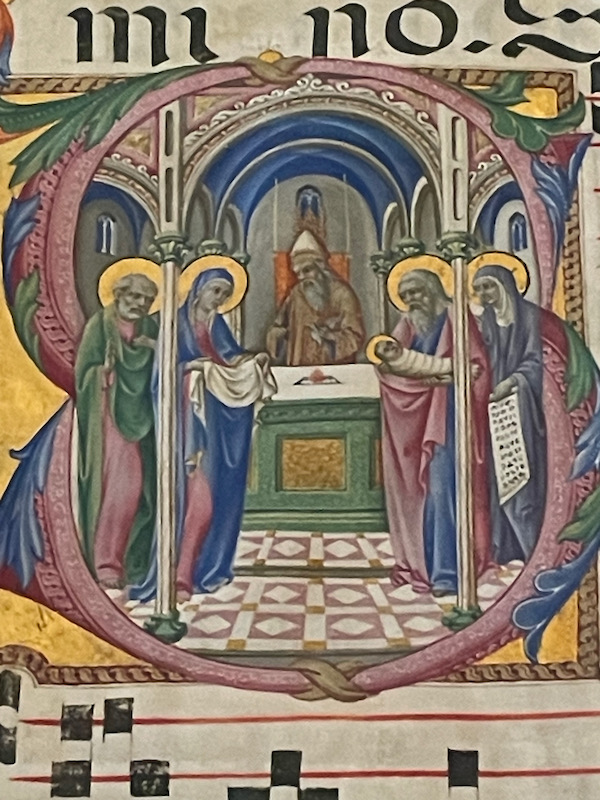
I mentioned that they started to build a "New Cathedral", but it was never finished. In one of the aisles that was completed, we visited the Museo dell’Opera, one of the oldest private museums in Italy. Some (if not all) of the statues that you see on the façade of the Cathedral are not the originals, but copies so that the originals could be preserved. Here are just a couple examples of the collection from the 14th and 15th centuries. The "Madonna of Forgiveness" is by Donatello.
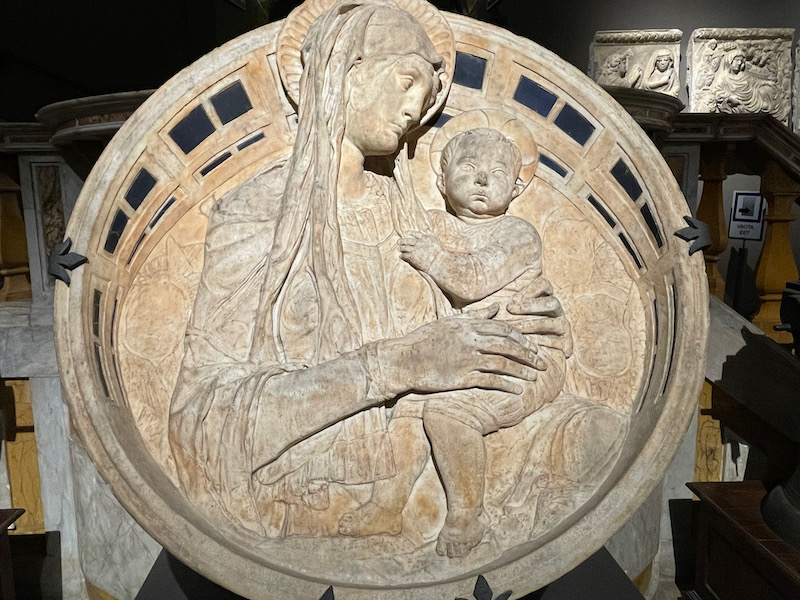
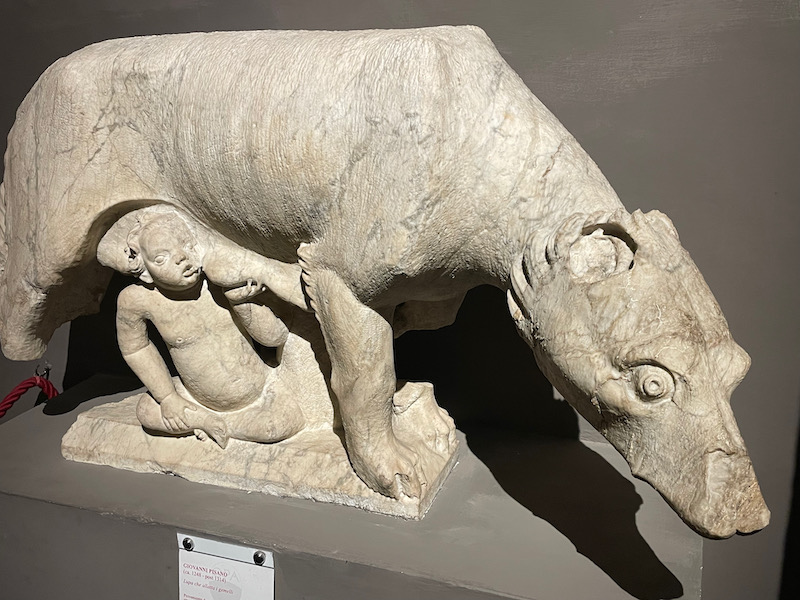
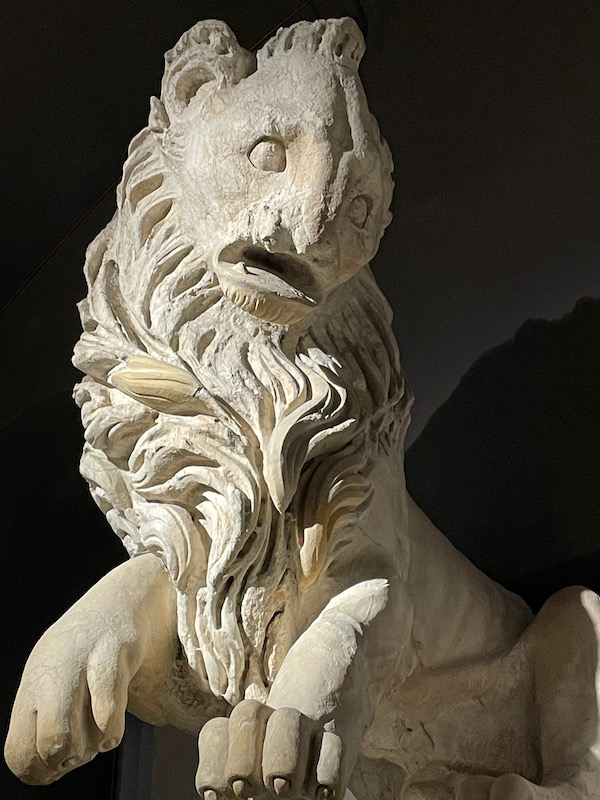
A statue of Saint Peter, done by Giovanni Pisano, who was one of the most influential artists of the 14th century. He worked on the statues on the Cathedral façade from 1284 to 1296.
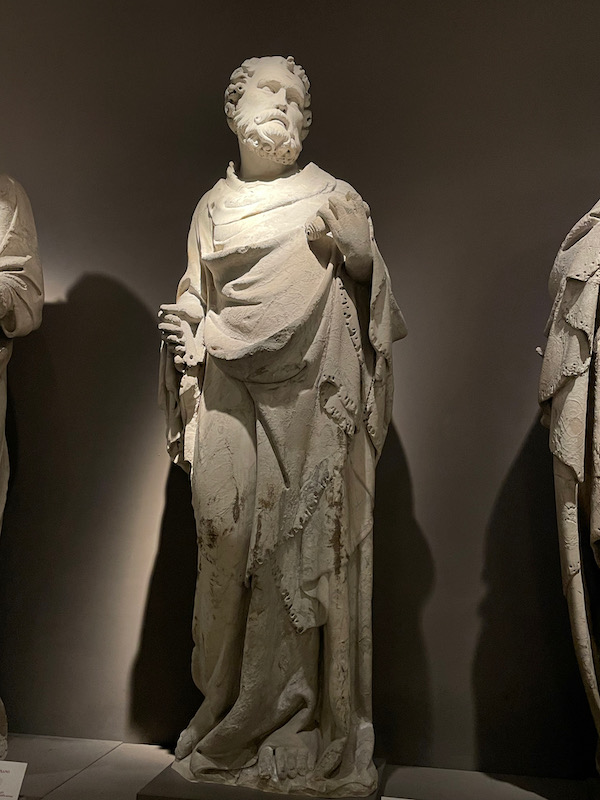
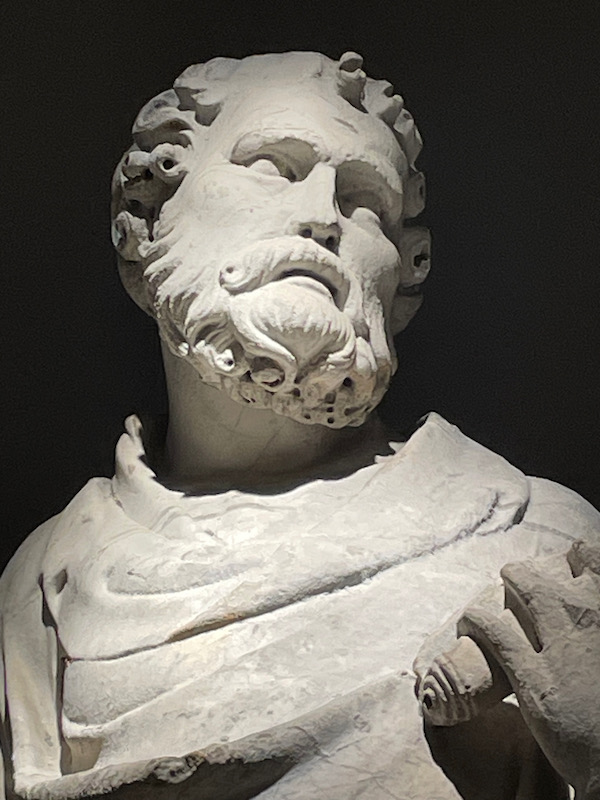
The museum also has a collection of wooden statues made by Jacopo della Quercia, and Italian sculptors who worked in wood, bronze and marble between 1419 and 1424. Here I have Saint Nicholas.
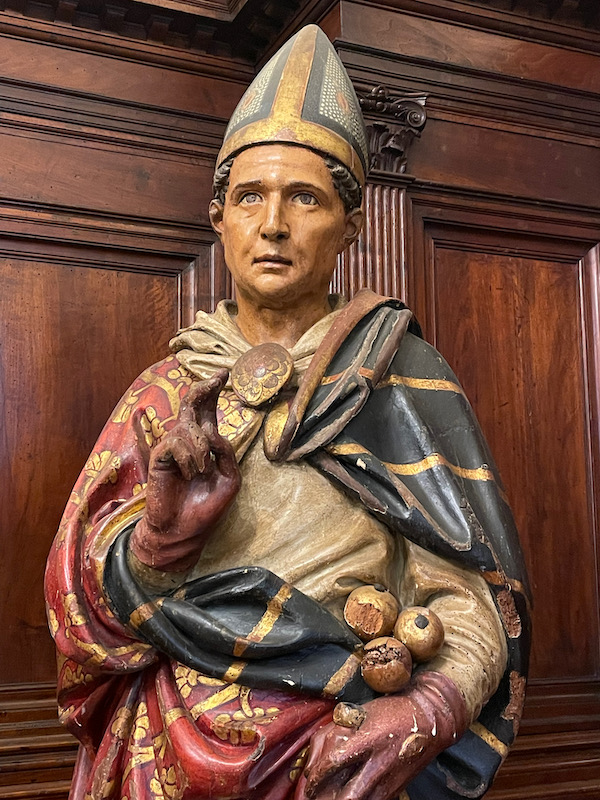
The Crevole Madonna, from 1284, is one of the early works of Duccio di Buoninsenga. You can tell that he was influenced by Byzantine art in the use of gold lines to create the sense of depth in the robes.
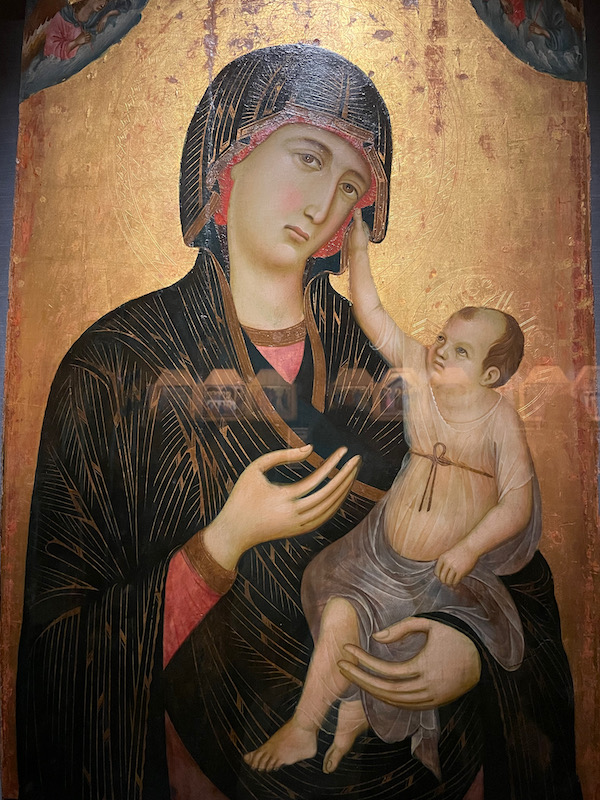
A great view of one of the gargoyles from the roof ... I don't normally get to see them so closely!
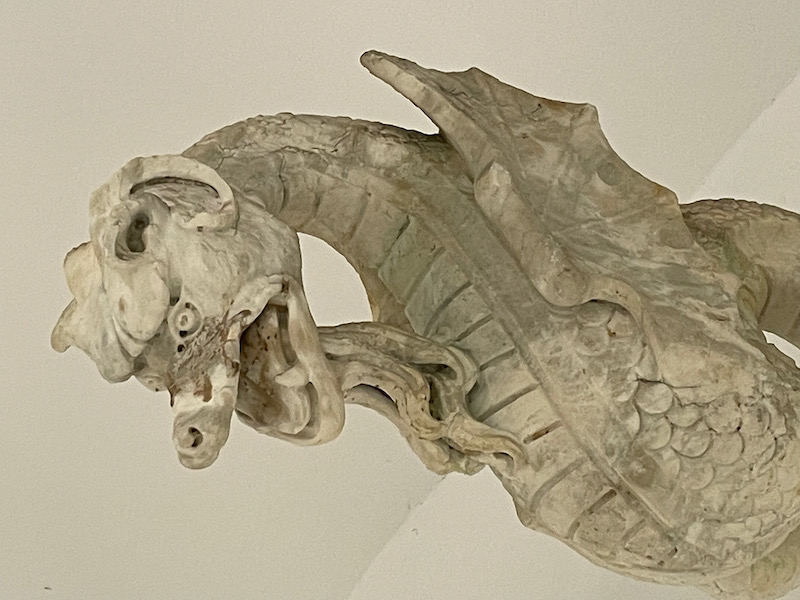
This I think dates from the 2nd or 3rd centuries and is from a Roman sarcophagus. Mind you ... the sign was only in Italian, so I could be wrong :-)
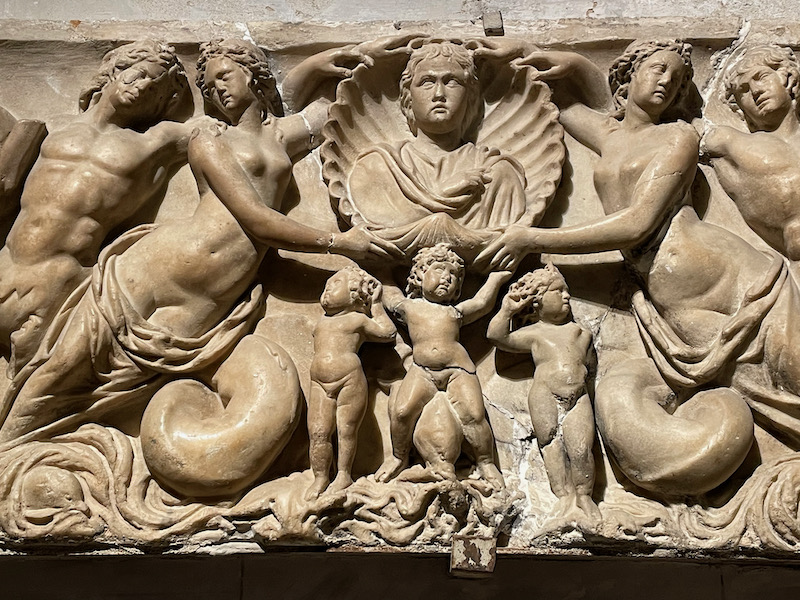
There is also a large stained-glass rose window that was made by Duccio di Buoninsegna to fill the round "oculus" opening above the chancel between 1287 and 1290. It was dismantled in 1943 to protect it from damage in the war. It is quite large (6 meters in diameter) and has 3 stories from the life of the Virgin Mary, along with a set of saints. I have a picture of the whole window, then a close-up of Saint Bartholomew and Saint Ansanus (middle pane on the left side).
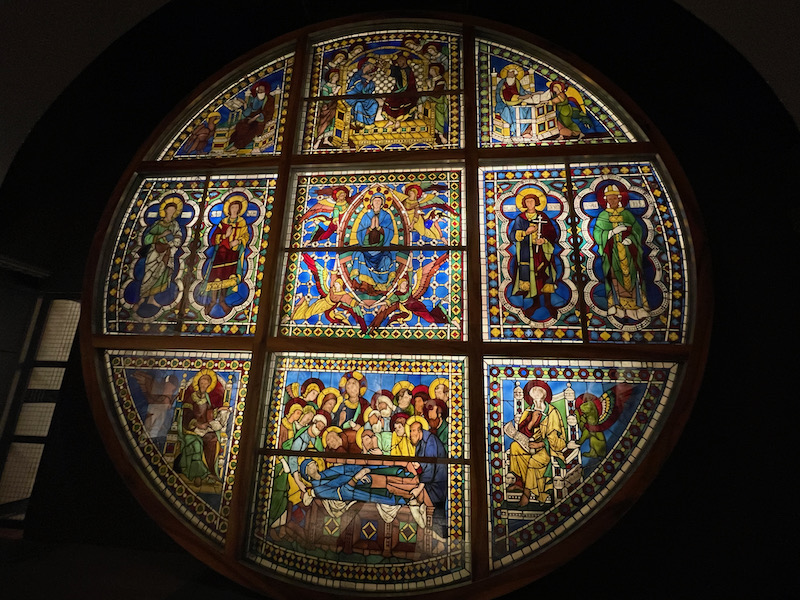
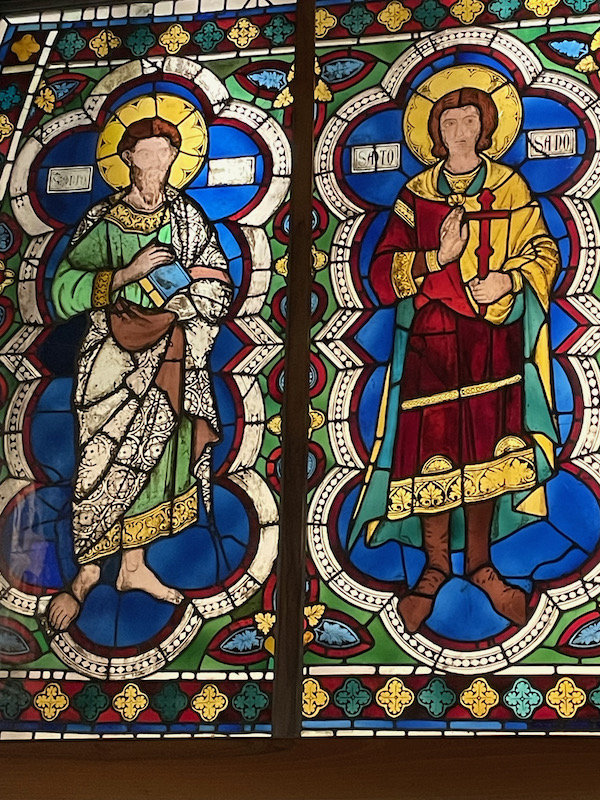
This group with Christ and 2 angels is the original .. the copies are just below so you can see where they would have been, up over a gateway.
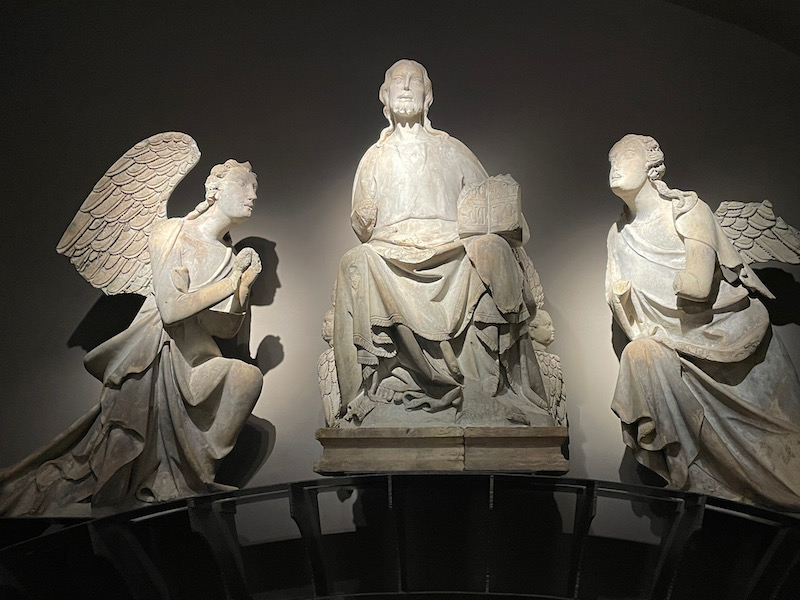
And the copies, in place over the gateway with all of the surrounding decoration.
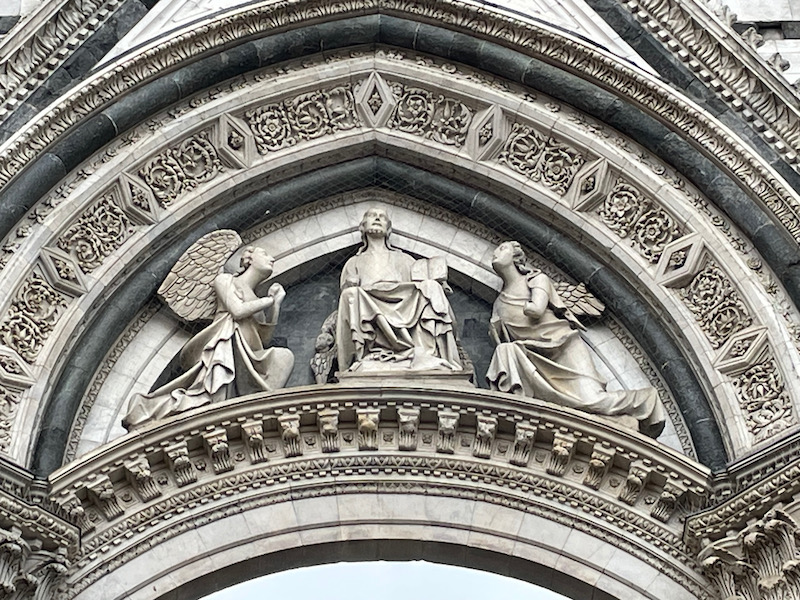
The crypt was only rediscovered only in 1999. It contains a series of 13-century frescoes which were sealed a few decades after they were painted, which is why they the colors are still so bright. This isn't the type of "crypt" that I was expecting ...normally they are burial areas but here, I didn't see any coffins.
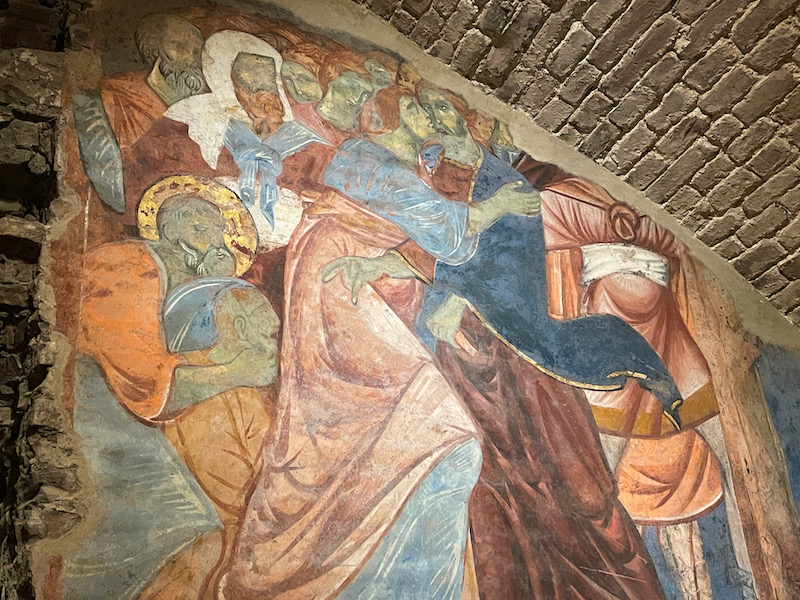
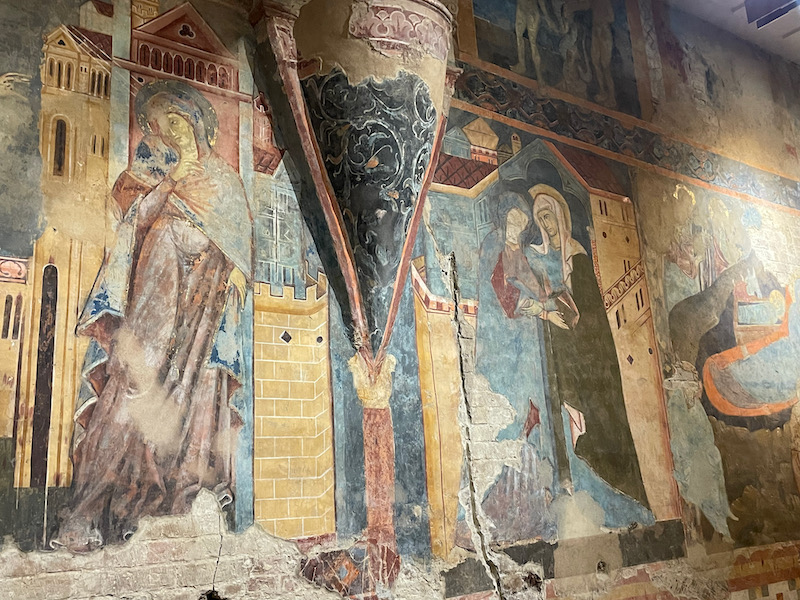
Behind the Cathedral is the Baptistery of San Giovanni, which has an interesting history. In 1317, they decided to lengthen the choir of the church by two bays. However, since the back wall of the choir was already close to a steep slope, the only way was to build a new building underneath it so that the ceiling of that building would support the floor of the new bays of the Cathedral choir. This new building was a new baptistery, which was completed in 1325. The marble façade, in Sienese Gothic style, was completed in 1382 (well ... supposedly the façade is actually unfinished).
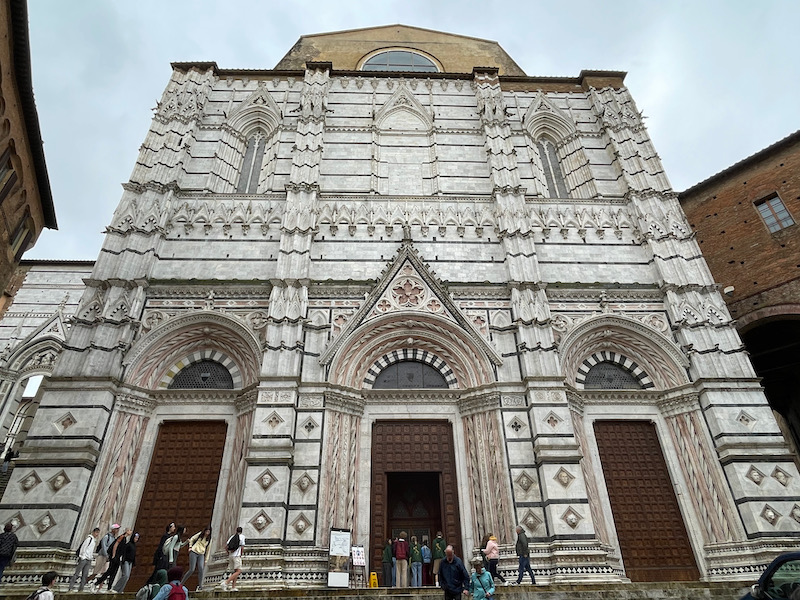
Inside, frescoes completely decorate the vaults while the walls have the same black-and-white-striped with the Cathedral bell-tower. The baptismal font, which is supposed to be impressive, was covered and we couldn't even take a peek at it, I grabbed a few pictures of some of the altarpieces.
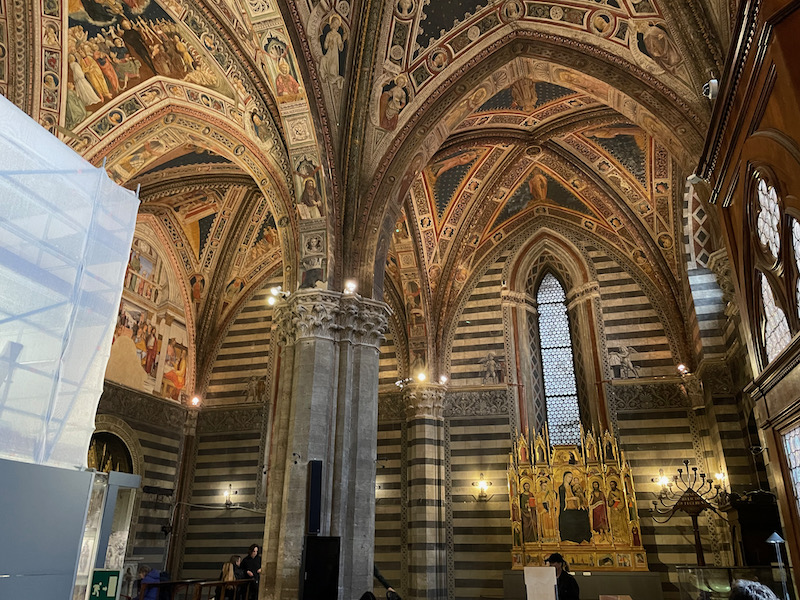
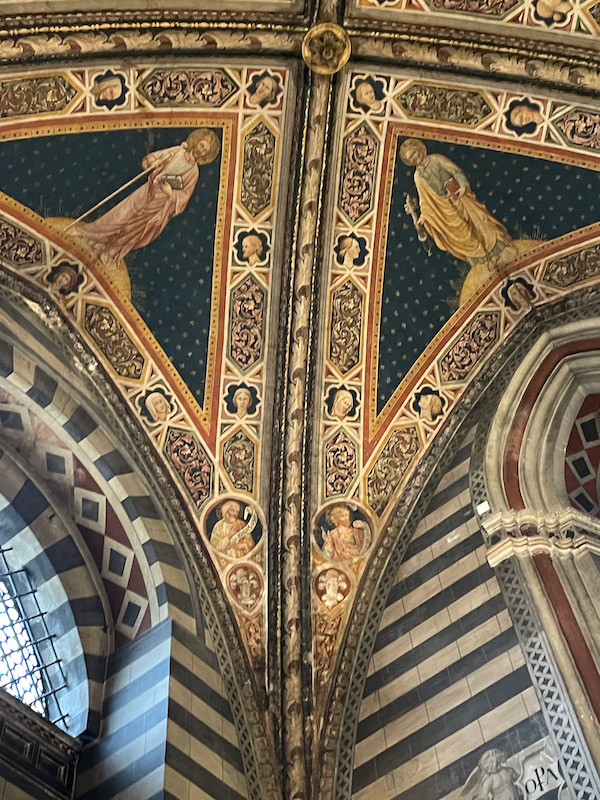
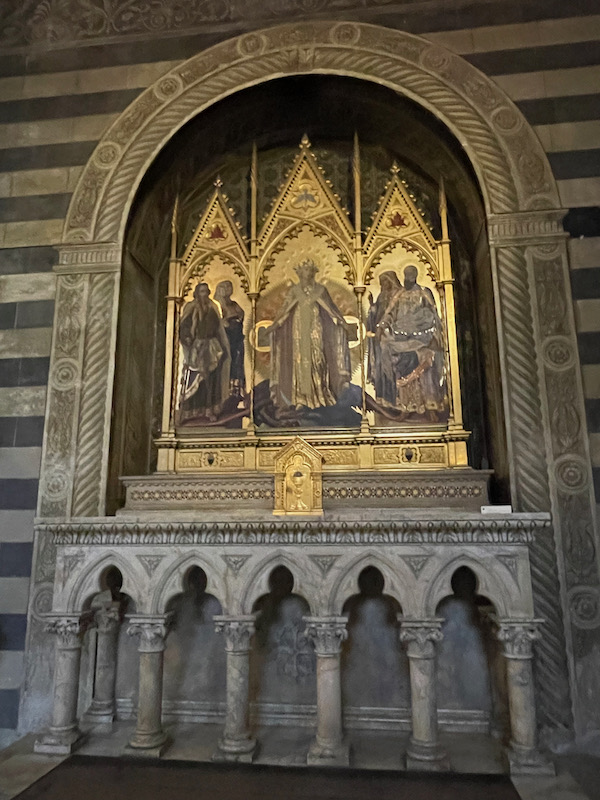
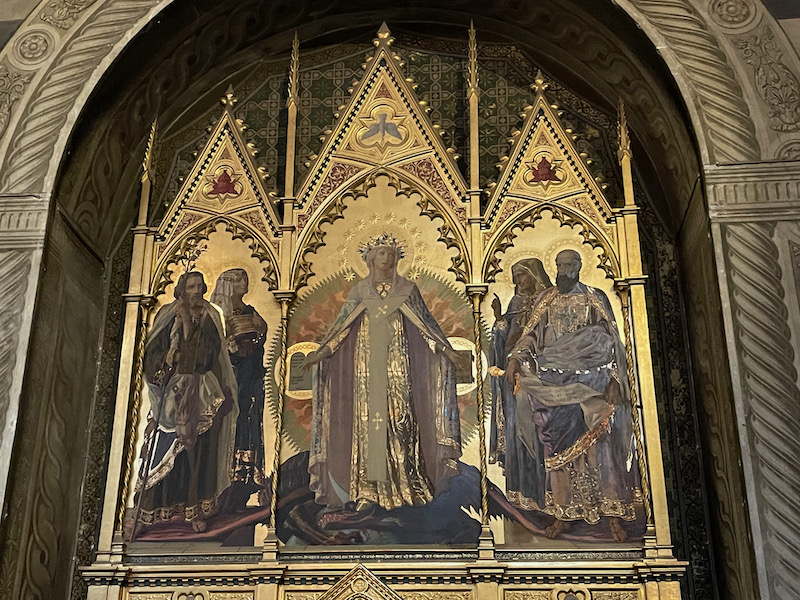
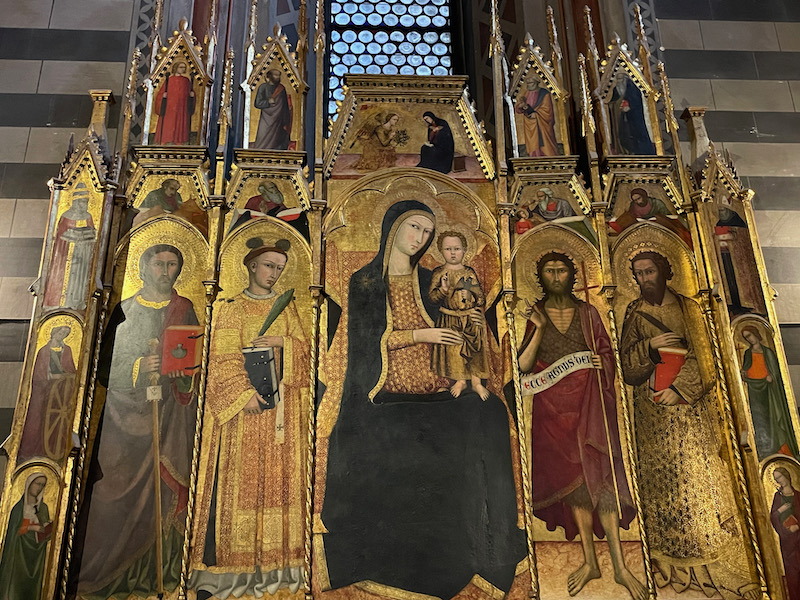
Then we headed out for the panoramic walk. This gives a good view of what was a "new cathedral" project. In 1339, the Cathedral was going to be expanded by adding naves on each side of the existing church. However, the work was interrupted in 1357 with only a few sections completed, including these tall arched bays, which would have been part of a new nave on the right-hand side of the church. I then gave a few pictures of the Cathedral in general from the top.
